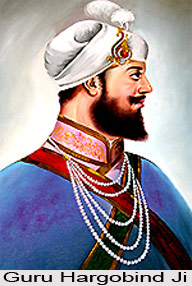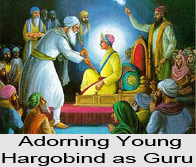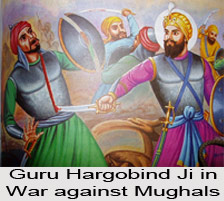 Guru Hargobind Ji is also known as "Saccha Padshah" meaning "True Emperor". He was born on 5th July 1595. He was the 6th of the Sikh gurus and became "Guru" on 25 May 1606 following in the footsteps of his father Guru Arjan Dev. He was 11 years old, when he became the "Guru," after his father"s execution by the Mughal Emperor Jahangir. He is remembered for initiating a military tradition within Sikhism to resist Islamic persecution and protect the freedom of religion. He had the longest tenure as "Guru", lasting for 37 years, 9 months and 3 days. Guru Hargobind married thrice, and his wives were Damodiri, Nanaki and Mahadevi.
Guru Hargobind Ji is also known as "Saccha Padshah" meaning "True Emperor". He was born on 5th July 1595. He was the 6th of the Sikh gurus and became "Guru" on 25 May 1606 following in the footsteps of his father Guru Arjan Dev. He was 11 years old, when he became the "Guru," after his father"s execution by the Mughal Emperor Jahangir. He is remembered for initiating a military tradition within Sikhism to resist Islamic persecution and protect the freedom of religion. He had the longest tenure as "Guru", lasting for 37 years, 9 months and 3 days. Guru Hargobind married thrice, and his wives were Damodiri, Nanaki and Mahadevi.
The Guru was brilliant in martial arts and an avid hunter. Guru Hargobind encouraged people to maintain physical fitness and keep their bodies ready for physical combat. Among the various activities that Guru Hargobind Ji has done during his reign, was that he advised every Sikh to keep a sword and maintain a horse with them always. However, all these activities and proclamations were seen as a challenge to the Mughal Empire and the Guru Hargobind Ji was imprisoned in the Gwalior fort, following a long battle with the Mughal army.
Early Life of Guru Hargobind Ji
Guru Hargobind was born in village Wadali in 1595. His father, Guru Arjan, was the 5th Guru of Sikh faith who had been arrested, tortured and killed under the orders of the Mughal Emperor Jahangir. Upon the death of his father, Hargobind undertook the role of Guru, at age 11. His father had advised him to start a military tradition to protect the Sikh people. At the time of his ascension, he put on 2 swords: "Piri" indicated his spiritual authority and "Miri", his temporal authority. He thus founded the military tradition in Sikh faith.
Leadership of Guru Hargobind Ji
During the era of Guru Hargobind, the Sikhs increased greatly in number. The armed system of Guru Hargobind had already formed the Sikhs into a kind of separate entity within the empire. Guru Hargobind excelled in matters of state, and his Darbar (court) was noted for its splendour. The arming and training of some of his devoted followers began, the Guru came to possess 700 horses, and his army grew to 300 horsemen and 60 gunners in the due course of time. Additionally, 500 men from the Majha area of the Punjab were recruited as infantry. Guru Hargobind built a fortress at Amritsar called "Lohgarh" meaning the "Fortress of Steel". He had his own flag and war-drum which was beaten twice a day.
Guru Hargobind Ji"s Wars with Mughals
The reasons for Guru Hargobind to arm his followers were many. Both externally and internally, the situation was changing. Sikhism had developed its organisation mostly during the tolerant days of Akbar. Akbar had never interfered with the development of Sikhism. He had even helped the Gurus in various ways. The death of his father at the hands of Jahangir prompted him to emphasize the military dimension of the Sikh community. He built a fort to defend Ramdaspur and created a formal court, "Akal Takht".
These aggressive moves prompted Jahangir to jail Hargobind at Gwalior Fort. But after finding Hargobind innocent and harmless, Jahangir ordered his release. According to Sikh tradition, 52 Rajas who were imprisoned in the fort as hostages for opposing the Mughal Empire were dismayed as they were losing a spiritual mentor. Guru Hargobind requested the Rajas to be freed along with him as well and stood surety for their loyal behaviour. Jahangir ordered their release as well. Hargobind got a special gown stitched which had 52 hems. As Hargobind left the fort, the captive kings caught the hems of the cloak and came out along with him.
During the reign of Shah Jahan, relations became bitter again. Shah Jahan was intolerant. He destroyed the Sikh Baoli at Lahore. Guru Hargobind defeated the Mughal troops near Amritsar in the Battle of Amritsar (1634). Guru Hargobind also fought the Battle of Kartarpur. He died at Rupnagar, Punjab in 1644.
 Legacy of Guru Hargobind Ji
Legacy of Guru Hargobind Ji
The following is a summary of the main highlights of Guru Hargobind Ji"s life:
•Transformed the Sikh fraternity by introducing martial arts and weapons for the defence of the masses.
•Carried two swords of "Miri" and "Piri".
•In 1608 he built the "Akal Takht" which is now one of five Takhts (Seats of Power) of the Sikhs.
•Founded the city of Kiratpur in Jalandhar district, Punjab.
•He was imprisoned in the fort of Gwalior for one year and on release insisted that 52 fellow prisoners be freed as well. To mark this occasion, the Sikhs celebrate "Bandi Chhor Divas".
•The first Guru to engage in warfare.
•The city Hargobindpur, in Majha region of Punjab, is named after him, which he won over from Mughals after defeating them in a battle.




















